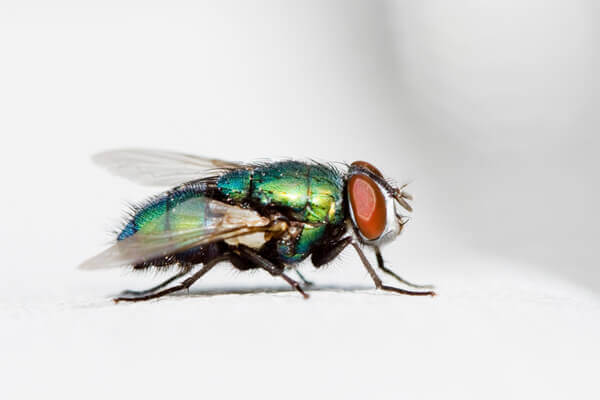What Do Blow Flies Look Like?

The term blow fly includes several species such as bluebottle and green bottle flies. These insects have metallic blue or green bodies and are slightly larger than the average house fly. They have large reddish-brown eyes and transparent wings. Blow flies are strong fliers that have a loud, distinct buzz when in flight.
A female blow fly can lay up to 200 tiny eggs in a cluster, and the pests’ yellowish-white larvae hatch quickly. These maggots have long bodies, tapered heads, and abdomens that are broad and flat. Their pupal cases look like capsules covered in a tough brown skin.
How Can I Tell if I Have a Blow Fly Problem?
As with most insects, seeing one or two blow flies in your home or business is nothing to worry about. However, it’s always important to watch for signs of infestation.
- Larvae – Adult blow flies lay hundreds of eggs on dirty dishes, pet droppings, spoiled meats and other decayed items that serve as meals for the pests. Spotting maggots feeding on these materials requires prompt removal and cleanup to avoid blow fly problems.
- Swarms – When it’s warm outside, a few blow flies may enter your house, school, or office as you go in and out. However, a large number of these insects gathered around a single area may indicate an animal carcass in a wall void.
- Buzzing – Before you see a swarm of blow flies, you may hear them. Their loud buzzing is annoying to residents and business owners, and it can indicate a bigger issue.
How Do Blow Flies Get Inside Homes and Businesses?
These small winged insects easily enter homes and businesses undetected. Cracked windows, torn screens, and broken vents make perfect entrances. Likewise, the pests often fly in through open windows and garages during the warm summer months.
Once inside, these pests migrate toward the nearest food sources. The insects often sneak into restaurants, grocery stores, delis, and school cafeterias whenever doors or loading bays are open. Blow flies then forage in kitchens, trash bins, and sinks for meals.
Are Blow Flies Dangerous?
While blow flies do not bite, they can cause other issues for residents and business owners. These pests feast on rotting organic materials like carrion, garbage, and feces. As a result, they pick up a wide range of disease-causing bacteria like Salmonella and E.coli. Blow flies then transfer these pathogens to any surface they touch.
Obviously, chefs, restaurant owners, and cafeteria workers cannot serve products contaminated by insects, which means blow fly infestations can lead to serious food and profit losses. This is especially important at cafeterias in hospitals where the food may make an already sick person sicker. Additionally, pests in commercial kitchens often result in health code violations as well as poor online reviews, which can ruin a company’s reputation.
How Can I Prevent Blow Fly Infestations?
The best way to take care of a blow fly – or any fly – infestation is to practice good hygiene and sanitation. Taking away their main food sources can deter these pests from lingering in your home or business. Remove any garbage before it spoils and keep trash cans tightly sealed.
Also, make sure to sanitize counters, cutting boards, or pots containing stored meats, vegetables, and other organic material or residue that may attract the insects. If you believe you have a blow fly problem, call or contact our team of experts at Waltham Pest Services.